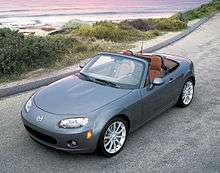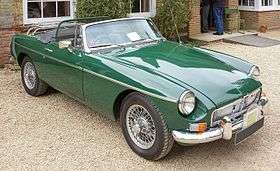Convertible
A convertible, cabriolet or spyder/spider (/ˌkæbrioʊˈleɪ/) is a passenger car that can be driven with or without a roof in place. The methods of retracting and storing the roof vary between models. A convertible allows an open-air driving experience, with the ability to provide a roof when required. Potential drawbacks of convertibles are reduced structural rigidity (requiring significant engineering and modification to counteract the effects of removing a car's roof)[1] and cargo space.[2]
The majority of convertible roofs are a folding construction made from cloth. Other types of convertible roofs include retractable hardtops (often constructed from metal or plastic) and detachable hardtops (where a metal or plastic roof is manually removed and often stored in the trunk).
Terminology
Other terms for convertibles include cabriolet, cabrio, drop top, drophead coupé, open two-seater, open top, rag top, soft top, spider, and spyder. Consistency is rare about the current use of cabriolet in preference to convertible.[3] The term cabriolet originated from a carriage cabriolet: "a light, two-wheeled, one-horse carriage with a folding top, capable of seating two persons", however the term is also used to describe other convertibles these days.[4]
In the United Kingdom, the historical term for a two-door convertible is drophead coupé, and a four-door convertible was called an all-weather tourer.[5] Nowadays, these names are generally used only for period cars.
History
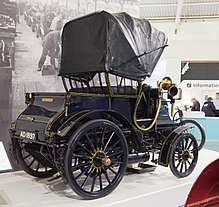
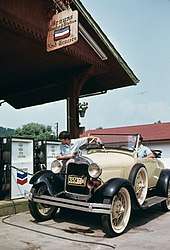
Most of the early automobiles were open-air vehicles without any roof or sides.[6][7][8][9] As car engines became more powerful by the end of the 19th century, folding textile or leather roofs (as had been used on victoria or landau carriages) began to appear on cars.[10][11] Examples of early cars with roofs include the phaeton (a two-seat car with a temporary roof), the brougham or a coupé de ville (having an enclosed passenger compartment at the rear, while the driver sat in front either in the open) or the landaulet (where the driver has a fixed roof and the passenger compartment has a folding roof). Less expensive cars, such as the runabouts, sporting roadsters or sturdy touring cars, remained either completely open air or were fitted with a rudimentary folding top and detachable side curtains.
In the 1920s, when steel bodies began to be mass-produced, closed cars became available to the average buyer and fully open cars began their disappearance from the mainstream market.[12] By the mid 1930s, the remaining small number of convertibles sold were high priced luxury models.[11]
In 1939, Plymouth introduced the first mechanically operated convertible roof.[13]
Demand for convertibles increased as a result of American soldiers in France and the United Kingdom during World War 2 experiencing the small roadster cars which were not available in the United States at the time.[12] These roadsters included the MG Midget and Triumph Roadster. United States automakers manufactured a broad range of models during the 1950s and 1960s – from economical compact-sized models such as the Rambler American[14] and the Studebaker Lark, to the more expensive models such as the Packard Caribbean, Oldsmobile 98, and Imperial by Chrysler.
During the 1970s, popularity of convertibles was severely reduced by the increased travel speeds on roads (resulting in more wind and noise for occupants) and proposed vehicle crash safety standards in the United States.[12][15] Automobile air conditioning systems and sunroofs were also becoming popular, reducing the demand for convertibles. After the last Cadillac Eldorado convertible was made in 1976, the only convertibles sold in the United States were imported, until Chrysler Corporation introduced 1982 models based on the K-Car. For Chrysler this was the LeBaron, and for Dodge, the 400.[16][17]
In 1989, Mazda released the first generation Mazda MX-5 (called "Miata" in North America), which has become the best selling convertible with over 1 million cars sold.[18]
Also in 1989, Toyota released the Toyota Soarer Aerocabin, which uses an electrically operated retractable hardtop roof.[19] Only 500 were produced,[20] however the retractable hardtop design has become increasingly popular in the 21st century.
Currently, models dedicated to the convertible body style include the Mazda MX-5, Porsche Boxster and Opel Cascada. Many other models also include a convertible body style in the model range.
Roof types
Textile
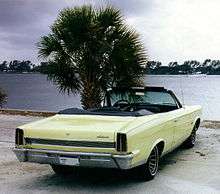
A "soft top" is made form a flexible textile material. Common materials for soft tops are:
- Early convertibles used cotton canvas woven so tightly it is waterproof. However, automakers had problems in securing raw materials to fulfill orders after World War II, including canvas in various shades for convertible tops and limiting their manufacture.[21]
- A cloth-based material has become more common in recent years.[22]
Other materials are also used in the convertible top. By 1955, the most popular materials were latex and butyl rubber fabrics that each accounted for around 35% of the convertible top weight, with others included vinyl (12%), jute (8%), and rayon and acrylic fibers (Orlon), amounting to about 1% each in the compositions.[23] Polyvinyl chloride (PVC) material was used for many convertible tops. The material consists of two layers: a top layer made of PVC, which has a specific structure depending on the vehicle model, and a lower layer made of fabric (usually cotton).
The collapsible textile roof section over an articulated folding frame may include linings such as a sound-deadening layer and/or an interior cosmetic lining, to hide the frame.
The folded convertible top is called the stack.
Detachable hardtop
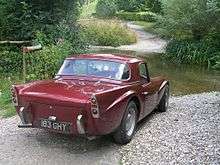
Rigid removable hardtops, many of which store in a car's trunk/boot, have been around at least since the 1950s.[24][25] These normally provide superior weatherproofing, soundproofing, and durability compared to fabric-based tops, some with integrated rear-window defrosters and windscreens.
Examples include the Ford Thunderbird (1st-generation and 11th-generation), Mercedes SL (2nd-generation and 3rd-generation), Porsche Boxster, Jeep Wrangler, Ford Mustang Cobra (1995 Only) and Mazda MX-5.
During the 1950s and 1960s, detachable hardtops were offered for various convertible sports cars and roadsters, including the 1955–1957 Ford Thunderbird and Chevrolet Corvette, as well as the 1963–1971 Mercedes-Benz W113 series of two-seaters. Because the convertible top mechanism is itself expensive, the hardtop was customarily offered as an additional, extra-cost option. On early Thunderbirds (and Corvettes through 1967), buyers could choose between a detachable hardtop and a folding canvas top at no additional cost, but paid extra for both.
The metal-framed "Carson top" was a popular addition for the 1930s Ford convertibles or roadsters because it turned these models into an almost instant hardtop.[26] The design mimicked a convertible top, but lacking the bulky folding mechanisms enabled the removable hardtop to have a much lower and more rakish profile.[27]
Improvements in canvas tops have rendered the detachable hardtop less common in recent years, in part because the top cannot be stored in the vehicle when not in use, requiring a garage or other storage facility. Some open cars continue to offer it as an option. For example, Mazda MX-5s has an accessory hardtop, which is compulsory for some auto racing series.
Retractable hardtop
A retractable hardtop — also known as "coupé convertible" or "coupé cabriolet" — is a car with an automatically operated, self-storing hardtop (as opposed to the textile-based roof used by traditional convertibles).
The benefits of improved climate control and security are traded off against increased mechanical complexity, cost, weight and often reduced luggage capacity.
Other design features
.jpg)
Tonneau cover
Folding textile convertible tops often fail to completely hide their internal mechanism or can expose their vulnerable underside to sun exposure and fading. A tonneau cover provides a solution.
Rear window
Rear windows are often part of the roof assembly. Traditionally, the rear window in a soft-top was made from plastic; however, more recently some convertibles have used glass for the rear window.[28]
Windblocker
A windblocker or wind deflector minimizes noise and rushing air reaching the occupants.[29] According to the engineer responsible for the 2008 Chrysler Sebring, its windblocker reduces wind noise by approximately 11 to 12 dB.[30]
Several convertibles are available with a heating duct to the neck area of the seat, which is often called an "Air Scarf". Examples of cars with an Air Scarf are the Mercedes-Benz SLK-Class, Mercedes-Benz SL-Class and Audi A5/S5.
Safety
Modern safety features specifically for convertibles include:
- rollover protection structures (ROPS) with pyrotechnically charged roll hoops hidden behind the rear seats that deploy under rollover conditions
- heated rear window (for improved visibility)
- boron steel-reinforced A-pillars
- safety cage construction – a horseshoe-like structure around the passenger compartment
- door-mounted side-impact airbag which inflates upward (instead of downward like the typical curtain airbag) to provide head protection even with an open window[31]
Variations
Convertibles have offered numerous iterations that fall between the first mechanically simple but attention-demanding fabric tops to highly complex modern retractable hardtops:
Roadster: A roadster (also called spider or spyder) is an open two-seat car with emphasis on sporting appearance or character. Initially an American term for a two-seat car with no weather protection, usage has spread internationally and has evolved to include two-seat convertibles.
Cabrio coach: A cabrio coach (also called semi-convertible) has a retractable textile roof, similar to a traditional convertible. The difference is that a convertible often has the B-pillar, C-pillar and other bodywork removed, however the cabrio-coach retains all bodywork to the top of the door frames and just replaces the roof skin with a retractable fabric panel.
An advantage of a cabrio coach is that retaining more of the car's original structure means that structural rigidity is higher (or the vehicle weight is lower) than traditional cabriolets.[32] An example of the cabrio coach is the 2003-10 C3 Pluriel,[32] which has a roof with five possible configurations.[33][34]
Fixed-profile: In contrast to convertibles where the entire bodywork above the beltline (doors, roof, side pillars, side bodywork) is replaced with a folding or retractable roof, the fixed profile convertible retain portions of fixed bodywork including the doors, side pillars, and side elements of the roof — while a center fabric portion slides back and accordions at the rear. As an example, Citroën's 1948 Citroën 2CV featured rigid bodysides and two doors on each side, along with a sunroof that rolled back on itself and extended to the rear bumper in place of a separate trunk lid. Other fixed-profile convertibles include the 1957 Vespa 400, 1950 Nash Rambler Landau Convertible Coupe, the Nissan Figaro (1991), the Jaguar XJ-SC (1983) and the 1957 Fiat 500 and its 2007 Fiat 500 successor. The 1984 Heuliez-designed Citroën Visa Décapotable used elements of a fixed-profile convertible.
Four-door: Most convertibles have two doors, however several four-door convertibles have been produced. Examples include the 1934 Buick Series 60 "Convertible Phaeton",[35] 1938-39 Buick Roadmaster, 1940–41 Buick Super, 1941-1947 Oldsmobile 98 1941-47, 1939 Cadillac Series 61, 1940-41 Cadillac Series 62 and 1961-67 Lincoln Continental.[36] Current production four-door convertibles include the Jeep Wrangler Unlimited.[37][38]
Peugeot presented a concept four-door retractable hardtop convertible, the Peugeot 407 Macarena in 2006.[39] Produced by French coachbuilding specialist Heuliez, the Macarena's top can be folded in 60 seconds,[39] with a steel reinforcing beam behind the front seats incorporating LCD screens for the rear passengers into the crossmember.[39]
Off-road: Several off-road vehicles have been produced with removable soft tops.[40] Examples include the Jeep Wrangler, Suzuki Vitara, Suzuki Jimny,[41] Ford Bronco, Land Rover Defender, Mercedes-Benz G-Class[42] and early models of the Toyota Land Cruiser and Land Rover Defender. Typically, the soft tops attach to the roll cage or to the installation points on the vehicle's body.
Landaulet: A landaulet (also known as landaulette) is where the rear passengers are covered by a convertible top.[43][44][45] Often the driver is separated from the rear passengers with a partition,[44] as per a limousine.
In the second half of the 20th century, landaulets were used by public figures (such as heads of state) in formal processions. They are now rarely used, for fear of terrorist attack.
Victoria-Cabriolet: reminiscent of the victoria carriage style, a three-position convertible. No rear side windows and equipped with a soft top which can be raised partway, leaving the area above the front seats folded back.[46] This bodystyle had a short period of popularity, mainly in the 1930s but extending into the neighbouring decades. Other names include Cabriolet/Coupé Milord (or just Milord), Calash (from Calèche), Folding Head DHC, three-position Drop-head Coupé, or Cabriolet toit de 3 positions.[47]
Gallery
Open car and roadster
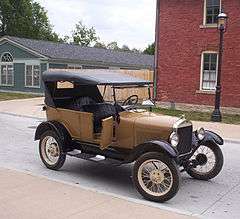 Ford Model T circa 1925, with minimal weather protection
Ford Model T circa 1925, with minimal weather protection Bentley 4½ Litre 1929 with luxury snap-on and thumbscrew sidescreens
Bentley 4½ Litre 1929 with luxury snap-on and thumbscrew sidescreens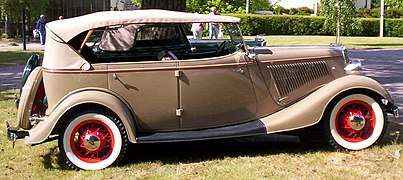 Ford Phaeton 1934 open four-door touring car
Ford Phaeton 1934 open four-door touring car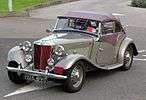
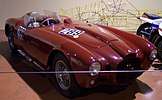 Lancia D23 Spyder 1953
Lancia D23 Spyder 1953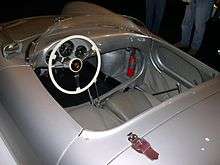 1955 Porsche 550 Spyder
1955 Porsche 550 Spyder
Convertibles
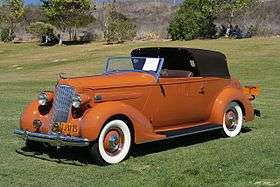 1936 Packard One-Twenty Convertible Victoria with the top in the semi-open (second) position
1936 Packard One-Twenty Convertible Victoria with the top in the semi-open (second) position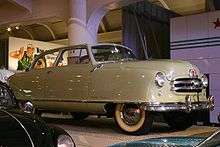 fixed-profile Nash Rambler Convertible "Landau" Coupe circa 1950
fixed-profile Nash Rambler Convertible "Landau" Coupe circa 1950 Jaguar XK circa 2008, with heatable glass rear window and fully automatic cloth top with integral top-concealing rigid tonneau
Jaguar XK circa 2008, with heatable glass rear window and fully automatic cloth top with integral top-concealing rigid tonneau.jpg) Mercedes SL 1964, available with a detachable hardtop
Mercedes SL 1964, available with a detachable hardtop.jpg) Lincoln Continental circa 1962, four-door with integral automatically operating, self-storing tonneau
Lincoln Continental circa 1962, four-door with integral automatically operating, self-storing tonneau- Jaguar E-type 1963, with vinyl foldable tonneau installed and snap-secured
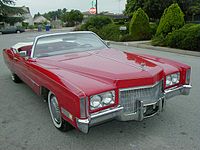 Cadillac Eldorado 1972, with detachable, two-part, fully rigid "parade boot" tonneau cover
Cadillac Eldorado 1972, with detachable, two-part, fully rigid "parade boot" tonneau cover Citroën 2CV fixed profile convertible circa 1975, with roll-back roof and rigid doors
Citroën 2CV fixed profile convertible circa 1975, with roll-back roof and rigid doors Rolls Royce Corniche circa 1986, a high-end prestige marque with a manually installed tonneau cover
Rolls Royce Corniche circa 1986, a high-end prestige marque with a manually installed tonneau cover Cadillac Allanté circa 1993, with detachable, rigid plastic tonneau cover.
Cadillac Allanté circa 1993, with detachable, rigid plastic tonneau cover. Volkswagen New Beetle circa 2003, with raised textile (cloth) convertible top featuring interior headliner, an acoustic insulation layer, and heatable glass rear window
Volkswagen New Beetle circa 2003, with raised textile (cloth) convertible top featuring interior headliner, an acoustic insulation layer, and heatable glass rear window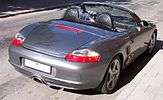 Porsche Boxster circa 2004, with detachable clear plastic windblocker and a Z-fold top, automatically raiseable in 12 seconds[48] and optional 51 lb (23 kg) detachable aluminum hardtop (not shown)
Porsche Boxster circa 2004, with detachable clear plastic windblocker and a Z-fold top, automatically raiseable in 12 seconds[48] and optional 51 lb (23 kg) detachable aluminum hardtop (not shown)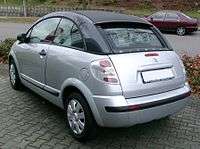 Citroën C3 Pluriel circa 2007, a multiconfigurable convertible with roll-back textile roof and removable rigid sidebars[33]
Citroën C3 Pluriel circa 2007, a multiconfigurable convertible with roll-back textile roof and removable rigid sidebars[33]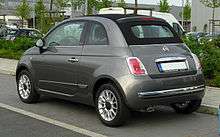 A Fiat 500 (2007) fixed-profile convertible
A Fiat 500 (2007) fixed-profile convertible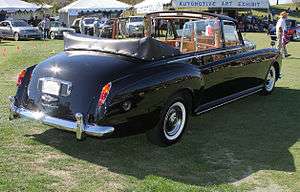 1966 Rolls-Royce Phantom V landaulet
1966 Rolls-Royce Phantom V landaulet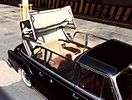 Mercedes-Benz 300d landaulet in operation
Mercedes-Benz 300d landaulet in operation
Retractable hardtop
.jpg)
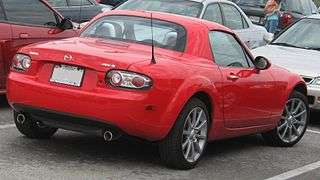 Mazda Miata Power Retractable Hard Top (PRHT) circa 2007, with 77 lb (35 kg) polycarbonate hardtop and identical cargo capacity to the soft-top version[49]
Mazda Miata Power Retractable Hard Top (PRHT) circa 2007, with 77 lb (35 kg) polycarbonate hardtop and identical cargo capacity to the soft-top version[49]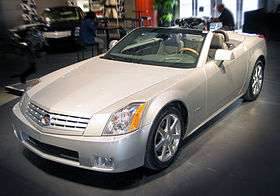 Cadillac XLR circa 2007, with fully retracted aluminum (i.e., lightweight) hardtop concealed by self-storing tonneau cover
Cadillac XLR circa 2007, with fully retracted aluminum (i.e., lightweight) hardtop concealed by self-storing tonneau cover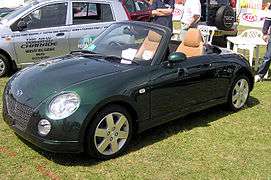 Daihatsu Copen circa 2001 with retracted hardtop, qualifying for the ultra-compact Japanese kei class
Daihatsu Copen circa 2001 with retracted hardtop, qualifying for the ultra-compact Japanese kei class- Ford Focus CC circa 2006 with its roof retracted, its final assembly performed by Pininfarina
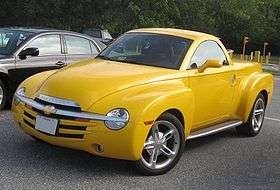 Chevrolet SSR circa 2004, a retractable hardtop convertible pickup truck, its top engineered by American Specialty Cars
Chevrolet SSR circa 2004, a retractable hardtop convertible pickup truck, its top engineered by American Specialty Cars- Volkswagen Eos circa 2007, the five-segment top features an independently sliding sunroof, made by OASys
See also
| Wikimedia Commons has media related to convertibles. |
References
- Garrett, Jerry (8 October 2006). "2007 Volkswagen Eos: In Praise of a Convertible Goddess". The New York Times. Retrieved 6 March 2011.To neutralize the loss of torsional rigidity inherent in any convertible, VW engineers took the basket-handle roll bar of the VW Cabrio, inverted it and placed it under the rear seat pedestal. A beefed-up windshield frame of hot-stamped ultra-high-strength steel is connected directly to the floorpan’s reinforced frame rails. Steel tubing provides more stiffness behind the doors for an extra layer of safety. Partly as a consequence, rear seat passengers have about 10 inches less shoulder room than in the smaller Rabbit.
- "What You Should Know Before Buying a Convertible". Edmunds. Retrieved 6 March 2011.
- "Convertible and Cabriolet what's the difference?". Convertible Car Magazine. 29 February 2012. Retrieved 11 July 2015.
- "Cabriolet". Dictionary.com. Random House. Retrieved 11 July 2015.
- Beattie, Ian (1977). The Complete Book of Automobile Body Design. Haynes Publishing Group. pp. 36, 42–43. ISBN 0-85429-217-9.
- "Beginnings of the automobile: the predecessor companies (1886-1920)". www.daimler.com. Retrieved 14 April 2018.
- "British Motor Manufacturers (1894-1960), Arnold". www.britishmm.co.uk. Archived from the original on 16 June 2011.
- "Early American Automobiles Pre 1900". www.earlyamericanautomobiles.com. Retrieved 14 April 2018.
- "Hurtu". www.gracesguide.co.uk. Retrieved 14 April 2018.
- "The Evolution of the Convertible- slide 2". www.popularmechanics.com. Retrieved 14 April 2018.
- "A brief history of the convertible". www.autofocus.ca. Retrieved 14 April 2018.
- "The up-and-down history of the convertible". www.cbsnews.com. Retrieved 14 April 2018.
- "The Evolution of the Convertible- slide 5". www.popularmechanics.com. Retrieved 14 April 2018.
- "All new (AMC advertisement)". Life. 50 (22). 2 June 1962. Retrieved 4 April 2014.
- "The Evolution of the Convertible- slide 8". www.popularmechanics.com. Retrieved 14 April 2018.
- Holusha, John (2 March 1981). "The U.S. Convertible Making a Comeback". The New York Times. Retrieved 14 August 2019.
- "The K Car: Variations on a Theme Helped to Save Chrysler". The New York Times. 29 January 1984. Retrieved 14 August 2019.
- "Mazda builds 1 millionth MX-5". www.autoblog.com. Retrieved 14 April 2018.
- "A Soarer Aerocabin Found In LA". www.speedhunters.com. Retrieved 14 April 2018.
- "This One Of 500 Toyota Soarer Aerocabin Can Be Yours". www.carscoops.com. Retrieved 14 April 2018.
- "The Last Roadster". Cars and Parts. 43: 42. 2000. Retrieved 11 January 2016.
- Stroll, Daniel (2009). Muscle Car Interior Restoration Guide. CarTech. p. 120. ISBN 9781932494983. Retrieved 11 January 2016.
- Jacobs, Milton (1957). Fabrics and Fibers for Passenger Cars: Automobile Manufacturers' Views, 1955 Compared with 1950, Issue 152 of Marketing research report. U.S. Department of Agriculture, Agricultural Marketing Service, Marketing Research Division. pp. 8, 40–41. Retrieved 11 January 2016.
- "A History of Hardtops". www.hemmings.com. Retrieved 15 April 2018.
- "356 Porsche Removable Hardtops". www.derwhites356literature.com. Retrieved 15 April 2018.
- Howley, Tim (April 2006). "A History of Hardtops". Hemmings Classic Car. Hemmings Motor News. Retrieved 6 February 2018.
- Auto Editors of Consumer Guide (19 September 2007). "Pisano/Ogden Buick: Profile of a Custom Car". HowStuffWorks.com. Retrieved 9 February 2014.
- "Convertible Buying Guide". www.consumerreports.org. Retrieved 29 April 2018.
- "Convertible buying info: Top-down driving". www.edmunds.com. Retrieved 29 April 2018.
- Chrysler Group (30 March 2007). "2008 Chrysler Sebring Convertible's Solid Structure and Systems Deliver Smooth Driving, Tight Handling and a Quiet Ride" (Press release). prnewswire.com. Retrieved 6 March 2011.
- "Volvo C70 - safety, the next generation". Autoblog.com.
- "The Semi-Convertible or Cabrio Coach: It's About Being Chic and Strong at the Same Time". www.autoevolution.com. Retrieved 5 April 2018.
- "Citroen C3 Pluriel (2003–) Review". Archived from the original on 5 November 2007.
- "Citroen C3 Pluriel". honestjohn.co. 28 May 2003. Retrieved 3 February 2014.
- File:1934 Buick Series 60 Convertible Phaeton.JPG
- Cars of the Sizzling '60s, by the auto editors of Consumer Guide (Publications International, Ltd., Lincolnwood, IL, 1997), pages 68 to 69, and 307.
- "Jeep history in the 2000s". www.jeep.com. Retrieved 8 May 2018.
- "2017 Jeep Wrangler". www.edmunds.com. Retrieved 8 May 2018.
- "¡Hey, Macarena! Heuliez Creates an Open-Top Peugeot 407". Edmunds. 28 January 2006. Archived from the original on 19 December 2006.
- "Evolution Of The Convertible SUV". www.autowise.com. Retrieved 8 May 2018.
- "Suzuki Jimny 2005 - 2012". www.autoevolution.com. Retrieved 8 May 2018.
- "2018 Mercedes-Maybach G650 Landaulet". www.caranddriver.com. Retrieved 8 May 2018.
- Georgano, Nick (2001). Beaulieu Encyclopedia of the Automobile. Routledge. p. 216. ISBN 978-1-57958-367-5.
- Clough, Albert L. (1913). A dictionary of automobile terms. The Horseless Age Company. p. 185. LCCN 13003001. Retrieved 1 September 2014.
- The Merriam-Webster new book of word histories. Springfield, MA US: Merriam-Webster. January 1991. pp. 358–359. ISBN 978-0-87779-603-9. LCCN 91029965. Retrieved 2 June 2012.
The motor landaulet was essentially an enclosed sedan or coupe with a folding top at the extreme rear quarter, over the rear seat.
- Haajanen, Lennart W. (23 May 2017), Illustrated Dictionary of Automobile Body Styles, 2d ed., McFarland, p. 34, ISBN 9780786499182
- Haajanen, p. 35
- "2007 Porsche Boxster news, pictures, and information". Conceptcarz.com. Retrieved 6 March 2011.
- Vaughn, Mark (10 September 2006). "2007 Mazda MX-5 Miata Power Retractable Hardtop". Autoweek. Archived from the original on 4 June 2011. Retrieved 6 March 2011.
Further reading
- Adler, Dennis (2011). Convertibles. First Gear series. Minneapolis, MN: Motorbooks. ISBN 9780760340202.CS1 maint: ref=harv (link)
- Hirsch, Jay; Weith, Warren (1979). The Last American Convertibles. New York: Collier Books; London: Collier Macmillan. ISBN 002080010X.
- Holmes, Mark (2007). Ultimate Convertibles: Roofless Beauty. London: Kandour. ISBN 978-1-905741-62-5.
- Langworth, Richard M (1988). The Great American Convertible. New York: Beekman House. ISBN 0517655810.
- Wieder, Robert; Hall, George (1977). The Great American Convertible: An Affectionate Guide. Garden City, NY: Doubleday. ISBN 0385131232.
